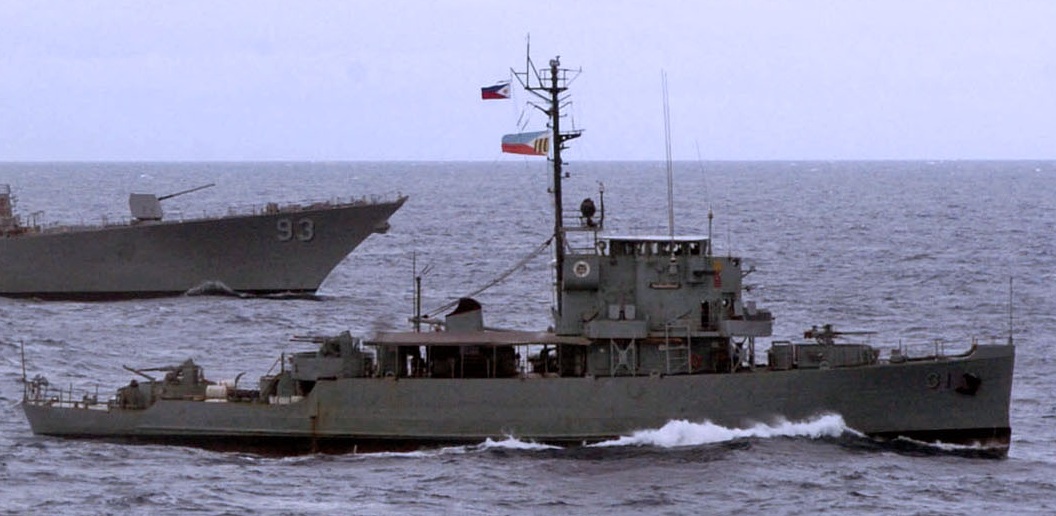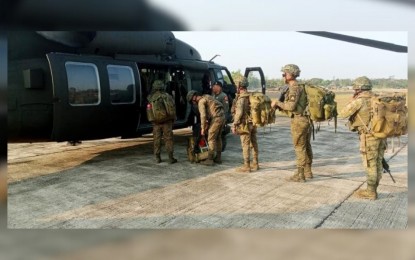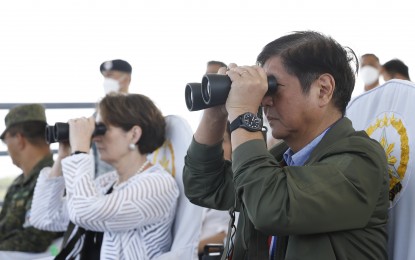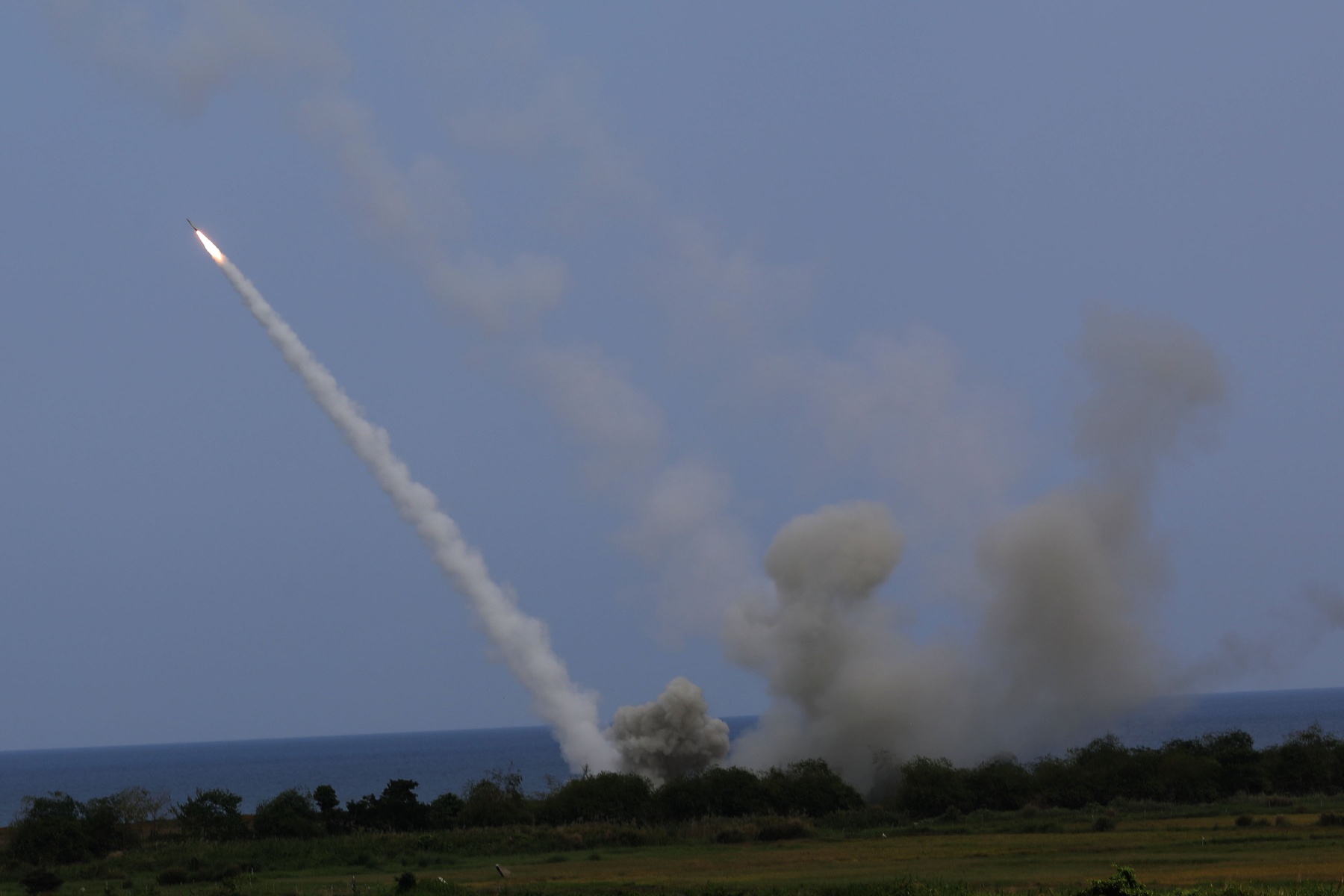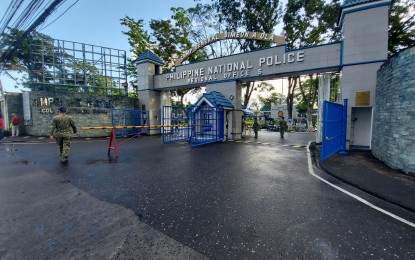From the Philippine News Agency (Apr 26, 2023): Balikatan live-fire drill participants sink retired WWII corvette (By Priam Nepomuceno)
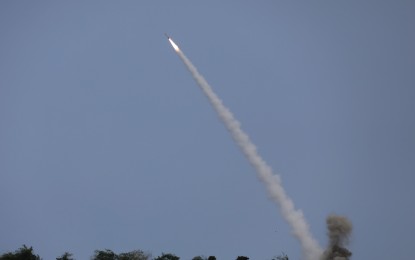 BALIKATAN. Weapon platforms and systems from participating US and Philippines military forces literally fired one after another and battered the decommissioned World War II corvette, BRP Pangasinan (PS-31), during combined joint littoral-live fire (CJLLF) exercise held at San Antonio, Zambales on Wednesday (April 26, 2023. The CJLLF exercise is the culminating field training event for "Balikatan" 2023. (PNA photo by Alfred Frias)
BALIKATAN. Weapon platforms and systems from participating US and Philippines military forces literally fired one after another and battered the decommissioned World War II corvette, BRP Pangasinan (PS-31), during combined joint littoral-live fire (CJLLF) exercise held at San Antonio, Zambales on Wednesday (April 26, 2023. The CJLLF exercise is the culminating field training event for "Balikatan" 2023. (PNA photo by Alfred Frias) MANILA –
Weapon platforms and systems of participating US and Philippines military forces literally fired one after another and battered and sunk the decommissioned World War II corvette, BRP Pangasinan (PS-31), during combined joint littoral-live fire (CJLLF) exercise held in San Antonio, Zambales on Wednesday.
The CJLLF exercise is the culminating field training event for "Balikatan" 2023 that started April 11 and will culminate on the 28th. The CJLLF exercise was held some 12 nautical from San Antonio, Zambales.
In an interview with reporters, Executive Agent of "Balikatan" 2023 Philippines Col. Michael Logico said the CJLLF started around 6:30 a.m. when missile frigate BRP Jose Rizal (FF-150) fired its 76mm autocannon at the designated target.
This was followed by the land-based artillery phase when the US high mobility artillery rocket system (HIMARS) fired at PS-31 and apparently missed.
It was the aviation engagement phase that had struck a telling blow against BRP Pangasinan as attack helicopters consisting of the Bell AH "Cobras" scored many hits against the target.
Both the US and the Philippines are known operators of the "Cobra" attack helicopters. Logico said BRP Pangasinan was sunk after being hit by a laser-guided bomb dropped by a participating American F-35B "Lightning II" around 2:55 p.m.
Earlier, a Filipino FA-50PH also scored hits against the target vessel using an AGM 65 also known as the "Maverick" air-to-surface guided missile.
The Embraer A-29 "Tucano" also took part and fired on the target vessel, Logico said. He also said the exercise was basically a success as the AC-130 “Spectre” gunship was no longer deployed to fire as the CJLLF was terminated with the sinking of the BRP Pangasinan.And when asked why the HIMARS seemed unable to score a hit, Logico said this system was designed as a "ground-based and area weapon and not a precision weapon" hence they were unsure on whether it would score a hit even before the exercise.
Another factor for HIMARS' lack of hits is the fact that the BRP Pangasinan was drifting since it proved impossible to anchor due to the extreme depth of the water in the target area.
However, Logico noted that Philippine and US artillery units were successful in the secondary target as it disappeared shortly during the salvoes fired by Filipino ATMOS 155mm self-propelled guns, and 105mm and so-called American Light Weight 155mm howitzers.
And when asked whether President Ferdinand R. Marcos Jr. was the first Philippine president to witness a major event of "Balikatan," the military official gave this answer: "I am not sure but I have been doing 'Balikatan' since 2017 and this is the first time in my experience at least that a President has actually witnessed a major event in 'Balikatan'."
Also, Logico said that "Balikatan" participants did not fire in the direction of Scarborough Shoal (Bajo De Masinloc) which lies more than 140 nautical miles.
"No, we did not shoot in the direction of Scarborough Shoal. We fired within 12 nautical miles which most of those artillery shells (are) inside Philippine territorial waters," he said.
And in reply to possible hostile reactions to the CJLLF exercise, Logico said the Philippines is merely exercising inside its territorial waters and inside its airspace.
Approximately 1,400 marines, soldiers, sailors, airmen and Coast Guardsmen from the US and Philippines took part in the training, which involved detecting, identifying, targeting and engaging a target ship using a variety of ground and air-based weapons systems.
"That is our inherent and invaluable right to exercise within our territory, we do not anticipate what will be their action," he said.
Interlopers delay drill
Logico also said that it is up to the "sensors" to verify the identity of the interlopers spotted and contributed to the delay in the exercise. One of the interlopers was from the air and the second one was from the water.
"I cannot verify that yet right now, it will be up (to) the sensors to verify that, safety is always a primary consideration when we conduct the exercise, any interloper or any intrusion into the exercise that will endanger the lives of people whether its intentional or accidental is our primary consideration so as a general SOP (standard operating procedure), we lift fires every time that there is an interloper," he noted.
Logico said the presence of the interloper, who appeared after the first HIMARS round was fired, forced them to pause the exercise due to safety reasons,
"The complication there was that in between that time from the registry round to the subsequent rounds there was some interloper that entered into our opera box (firing range) and per our SOP, any interloper would mean that that we would have to pause the exercise, we don’t know if the interloper was accidental or it was intentional," he added.
"Between the time, PS-31 has already drifted a considerable distance so they have to recompute again because PS-31 was set adrift into the water because at the depth we cannot anchor it so we allow it to drift and then calculate for the drift but by the time that the rounds (were) released to the time it takes for them to reach 12 nautical miles away, there is a very strong possibility that the PS-31 is no longer in the last registered position," Logico said.
He also did not comment on whether the Armed Forces of the Philippines (AFP) plans to acquire the HIMARS as part of its ongoing modernization program.
"I am not involved in (the) AFP modernization (program), I am just involved in the exercise so I cannot speak for what goes on in the modernization planning. What we actually demonstrated was the capabilities of the HIMARS and probably also its limitations to give our senior leaders a more informed decision on modernization but then again I cannot also talk about the procurement process, we only talk within the topic of the exercise," he added.
The military official also stressed that the reason for the ongoing "Balikatan" exercises is to show the AFP's capability to be interoperable with its US counterparts and treaty ally.
Combined ops ‘inherently hard’
And when asked about possible lessons that might be learned from the CJLLF exercise, Logico said this shows combined operations is "inherently hard".
"Difficult because you’re dealing with two different organizations, two different cultures and it is good that we share almost the same doctrines when it comes to warfighting. So the challenges were already predetermined by us and that is what we were working through," he added.
Logico also emphasized that while it is easy to fire any weapon systems, the ability to "deconflict" (reduce friendly fire) all those platforms is a challenge in itself.
"And if we were, all we wanted todo was come up with a performance of fires that will fire successively we lose the point of the entire exercise, so yes the President watched the exercise and he understands the challenges that is entailed in doing a combined operation at this level and from that the appreciation of the President is what we came out with," he added.
Also, the ongoing "Balikatan" exercises shows that the military alliance between the US and the Philippines is very much alive, he added.
This year's "Balikatan" is the largest annual exercise between the two allies and 2023 marks its 38th iteration and the largest iteration to date, with more than 17,600 participants.
“This training increased the exercise’s realism and complexity, a key priority shared between the Armed Forces of the Philippines and the US military,” US Marine Corps Forces, Pacific commander and US director for "Balikatan" Lt. Gen. William Jurney said.
The exercises provide an opportunity for the two militaries to enhance cooperation, increase capabilities and improve interoperability.
“Together we are strengthening our capabilities in full-spectrum military operations across all domains,” Jurney said.
The "Balikatan" exercise has increased in complexity and high-end warfighting mission sets over the past several years. A focus point in "Balikatan" 2023 was bilateral integration of command and control, sensors, and multi-domain fires.
This enabled expanded battlefield awareness, the sharing of targeting data between geographically dispersed units, and precision strikes in a contested maritime environment.
During the littoral live-fire event, a US Marine Corps command and control and sensor network enabled the various firing platforms to sense their target, develop firing solutions, and deliver precision integrated fires against the target vessel.
The training event represented a tangible demonstration of the US-Philippine commitment to strengthen military capabilities and interoperability to meet shared modern-day security challenges.
“This significant activity demonstrated new potential and revitalized the strength of our militaries while we continuously forge an ironclad alliance,” AFP Education, Training and Doctrine Command chief and "Balikatan" Philippine director Maj. Gen. Marvin Licudine said.
He added that this event enhanced the interoperability of the Philippines and US forces in conducting combined joint operations.
The training successfully advanced combined military modernization and capability development by furthering the opportunities for both Philippine and US forces to work together in a complex and realistic training environment.
The US-Philippines Mutual Defense Treaty was signed in 1951 and is America’s longest standing defense treaty in the Indo-Pacific Region. Together, the United States and the Philippines are committed to promoting regional peace and stability.
https://www.pna.gov.ph/articles/1200206




